Effective product labeling is vital in the cannabis world. It helps build trust and strengthens your brand’s image. How can you make sure your CBD labeling is SEO-friendly?
It’s key to understand the rules and put important details on your labels. This step makes sure you follow the law and wins your customers’ trust. Picking a great label design and following legal rules also boosts your brand’s look. It’s also crucial to stay honest and follow advertising laws to keep trust and stay within regulations.
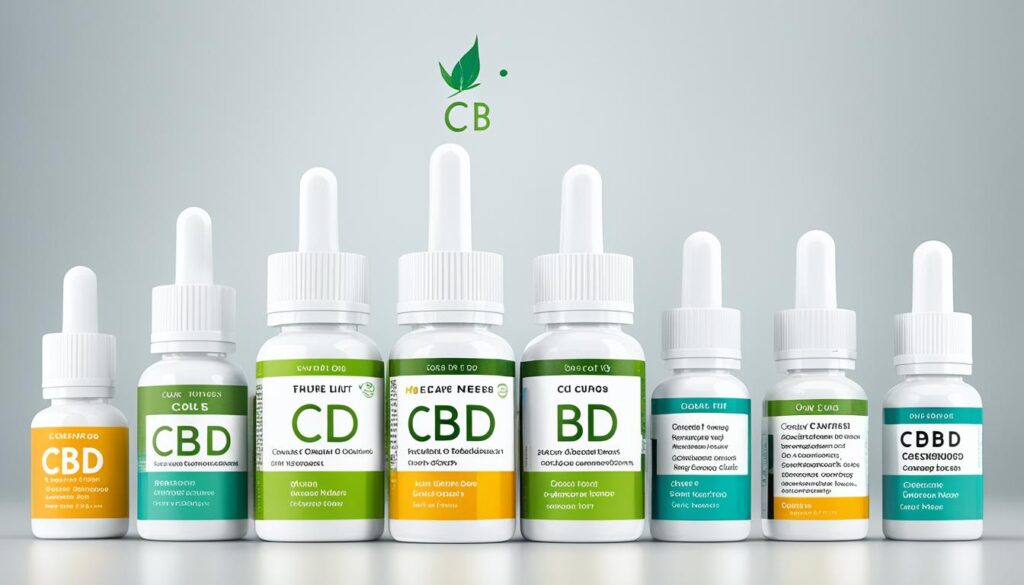
- Effective product labeling is crucial for building consumer trust and brand reputation in the cannabis industry.
- Understanding regulatory requirements and including key information on labels are essential for legal compliance and customer confidence.
- Choosing the right label design and complying with legal guidelines enhance brand identity.
- Avoiding misleading claims and advertising restrictions is important to maintain compliance and build trust with consumers.
- Stay tuned to discover the best practices for SEO-compliant CBD labeling.
Understanding Regulatory Requirements for CBD Product Labeling
Different states have their own rules for cannabis product labeling. CBD businesses must know and follow these rules. Doing so helps avoid legal problems and keeps customer trust.
Putting time and effort into understanding these laws is key. CBD labels need to show things like strength, strain type, how it was grown, and how it was made. Doing this follows the rules and helps customers trust and understand the product more.
Labels should clearly show THC and CBD levels. This helps customers know how strong the product is. They should also tell if the strain is Sativa, Indica, or Hybrid. This explains the effects to expect. Adding how it was grown (like organic or indoor) tells about the quality and safety.
Telling how the CBD was made is also important. For instance, if it’s made using CO2 extraction. This assures customers that the product is safe and made right.
“Understanding and following the rules for CBD labeling is key. It helps avoid legal issues and builds trust with customers.” – [Insert Expert Name], CBD Industry Specialist
It’s also vital to have safety warnings on labels. These warnings can include things like how to store the product and who shouldn’t use it. This protects both the customer and the company.
By sticking to the rules for CBD labeling, businesses can work within the law. This protects their reputation and gives accurate info to customers. Following these rules shows the company’s integrity and commitment to following the law.
| Regulatory Requirements for CBD Product Labeling | Key Considerations |
|---|---|
| Potency | Indicate THC and CBD levels to inform consumers about product strength. |
| Strain Typology | Specify whether the strain is Sativa, Indica, or Hybrid for desired effects. |
| Cultivation Information | Include cultivation methods to provide transparency and quality assurance. |
| Processing Methods | Disclose the extraction or manufacturing processes to ensure consumer safety. |
| Safety Warnings | Include necessary safety warnings, age restrictions, and storage instructions. |
Key Information to Include on CBD Product Labels
For clarity and compliance, CBD product labels need specific details. They should inform buyers about THC and CBD levels, strain types, and names. You should also know how it was grown, processed, its unique traits, safety notes, and age limits.
The strength of a CBD item is key. Labels showing THC and CBD amounts let users know the effect strength. Strain types like Sativa, Indica, or Hybrid hint at expected outcomes, aiding in picking the right product.
Strain names add clarity on labels. They tell you the product’s origin. Knowing if it’s a well-known strain or a new blend can guide users towards preferred effects.
How a CBD product is grown matters. Labels should share this, highlighting the origin and quality. Info on organic growth or the use of outdoor, indoor, or hydroponic farming impacts buying choices.
Labels must also outline how the CBD was extracted. CO2 extraction ensures purity and quality. This method being mentioned assures consumers about the product’s safety.
Distinguishing features on labels help a CBD product stand out. These can include being locally grown or pesticide-free. Such details catch the buyer’s attention, informing them further.
Safety tips and age limits must be clear on labels. They’re vital for keeping buyers safe and meeting legal standards.
In summary, CBD labels need to be detailed and clear. They should talk about THC and CBD content, strain details, how it’s grown and made, and unique traits. Also, safety warnings and age restrictions are a must. This aids buyers in making smart choices while ensuring products meet regulations.
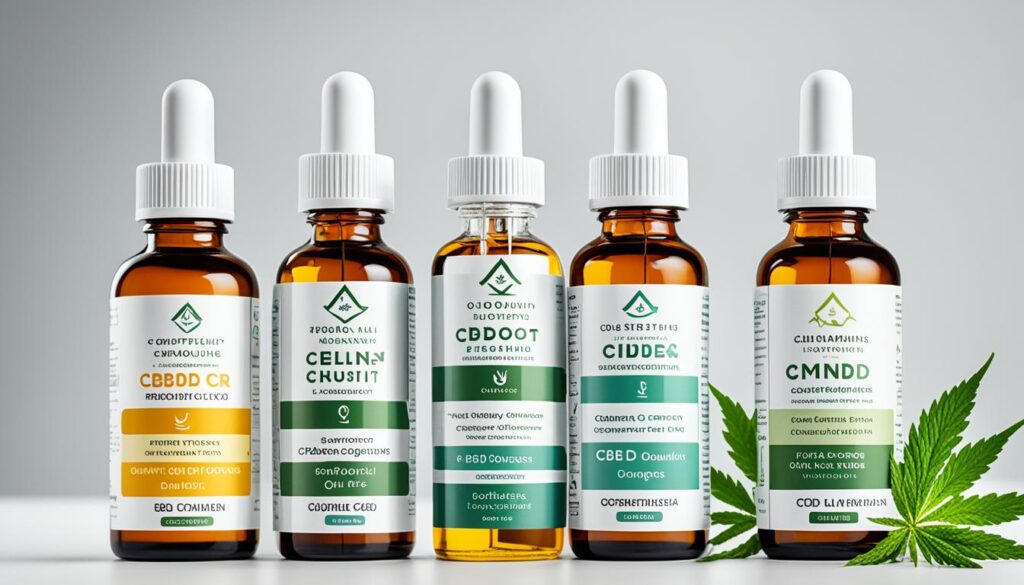
Choosing the Right Label Design for CBD Products
When it comes to CBD product labels, looks and compliance matter. They must follow rules while showing off the brand’s style and earning customer trust. Clear information and a good mix of visuals are key. Also, having the same design on all products helps people recognize your brand easier.
Designing CBD labels is all about staying legal and looking credible. Catchy visuals, like logos and colors, can grab attention and make your brand stand out. Choosing the right font and colors to match your brand makes the label unforgettable and draws in customers.
It’s important for labels to be easy to read. Names, ingredients, doses, and warnings need to be clear. This clarity helps customers get key details without confusion. Mixing must-have info with attractive design makes the label both useful and nice to look at, increasing trust.
Keeping a consistent look across all CBD products helps build brand loyalty. Using the same colors, fonts, and styles makes your brand easy to recognize and trust. This consistency makes people feel more connected with your products.
Take “GreenLeaf Naturals” for example. They chose their labels well, matching their brand’s vibe. Their labels combine green shades and nature images to feel genuine and trustworthy. Having the same design elements on all products makes them easy to spot and remember, which builds loyalty.
Having a consistent design also helps on shelves or online, where people can quickly find what they know. This consistent look makes your brand pop out among others, creating a reliable and familiar feeling for consumers.
Benefits of choosing the right label design for CBD products:
- Enhanced brand credibility and trust
- Improved visual appeal and customer engagement
- Established brand recognition and loyalty
- Effective differentiation in a competitive market
- Streamlined product identification and consumer decision-making
Picking the right label design—and sticking with it—makes a brand more credible and legally safe. Putting in the effort pays off with stronger brand presence, loyal customers, and better business outcomes.
| Compliant Label Design Practices | Benefits |
|---|---|
| Following regulatory requirements | Legal compliance and customer trust |
| Integrating visually appealing design elements | Attracting consumer attention |
| Ensuring legibility of mandatory information | Transparency and customer understanding |
| Maintaining consistency in design across products | Brand recognition and loyalty |
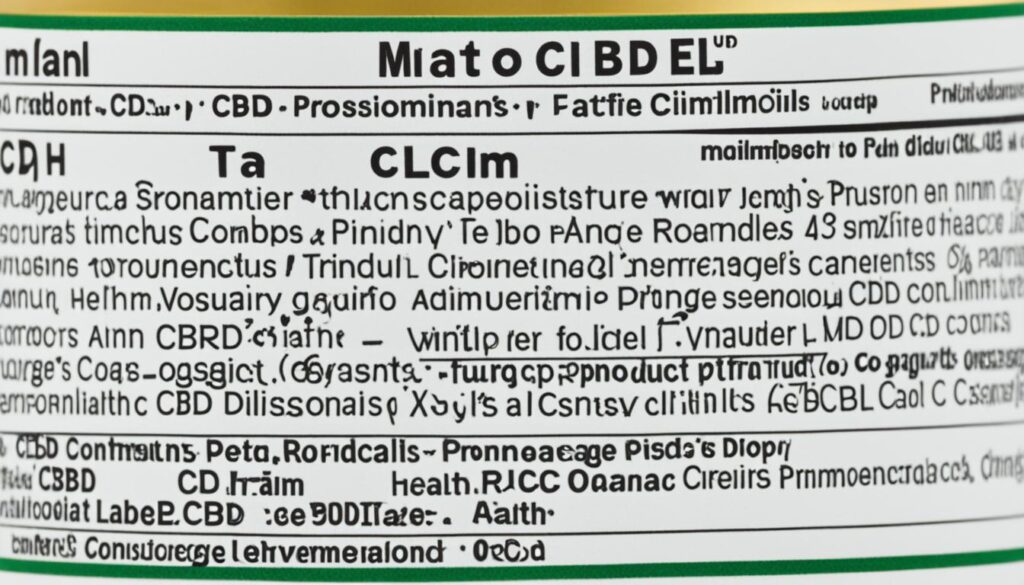
Complying with Legal Guidelines for CBD Product Labeling
It’s vital for the success of your brand to follow legal rules for CBD labeling. Understanding both state and federal laws is key. The Food and Drug and Cosmetic Act (FD&C Act) sets important standards for packaging.
To label your products right, match your tactics with laws. Use third-party labs and check your labels often. This keeps you legally safe and ensures label truthfulness. It’s also key to regularly update yourself on law changes.
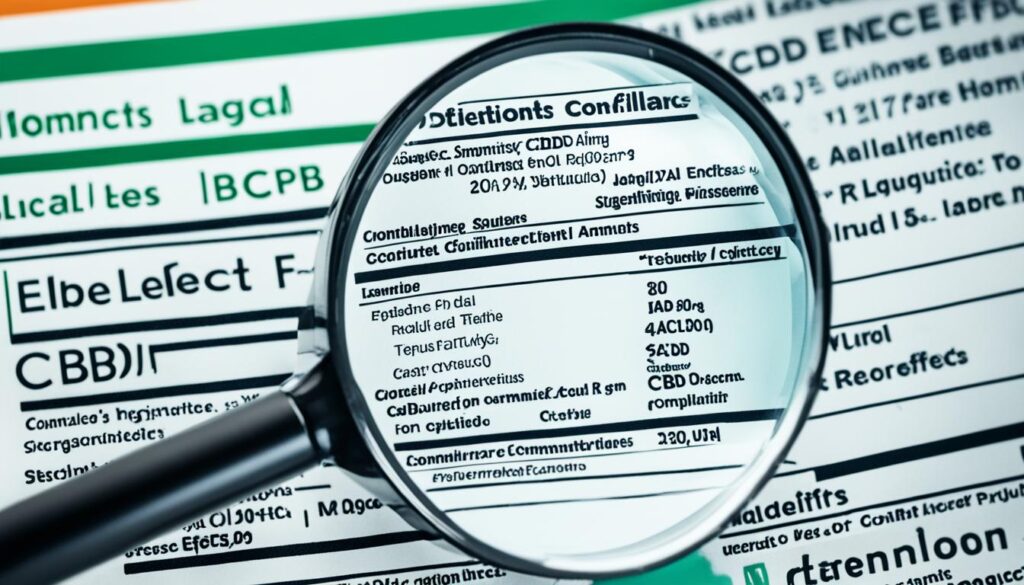
Understanding State and Federal Laws
Following state and federal laws is critical for CBD labeling. Each state has unique rules on labels, THC levels, and what you can claim. Knowing these laws helps you stay compliant and steer clear of legal issues.
The FDA also sets rules for CBD labels. They limit health claims and require clear ingredient lists. That’s why understanding these laws is crucial.
Meeting Packaging Standards
Good packaging is essential for safety and customer trust. It keeps your brand safe from legal trouble. Use packaging that meets all legal requirements.
State and federal laws guide how you should package your products. Following these guidelines shows your dedication to quality and safety. This might mean child-safe packaging, clear labels, and necessary warnings.
Regular Compliance Reviews
The CBD market changes often, so keeping your labels up-to-date is a must. This helps you stay on top of new laws. It keeps you away from legal issues.
Review your compliance and know the laws well. Adjusting your labels as needed keeps you legally safe. Doing this shows your commitment to transparency and safety.
Prioritizing legal rules in your CBD labels protects your brand. Understand and follow laws, ensure packaging quality, and do regular checks. This will make your labels accurate and build trust with customers.
| Benefits of Legal Compliance | Legal Pitfalls to Avoid |
|---|---|
| – Protects your brand reputation | – Misleading or false product claims |
| – Builds trust with consumers | – Non-compliance with state and federal laws |
| – Prevents legal complications | – Inadequate or improper packaging |
| – Demonstrates commitment to transparency | – Failure to disclose accurate product information |
Avoiding Misleading Claims and Advertising Restrictions for CBD Products
Misleading claims can hurt the CBD industry, harming its reputation and finances. To dodge such problems, staying updated on regulations and policy shifts is key. Craft precise, true product descriptions. Avoid overstatement of effects or benefits. Make sure all label info is checkable and supported by documents. Think about the law and morality in every ad choice. Using educational content to spread awareness about CBD products is a smart marketing move.
When selling CBD products, companies should be careful of legal and ethical implications of false claims. With changing rules, following ad restrictions is vital to keep a good brand name and trust. Marketing methods should follow all laws to escape legal issues.
“Honesty is the best policy” matters in CBD product ads too. Not making misleading claims and following ad rules help build trust. It’s important to show CBD benefits and effects truthfully, giving real expectations.
Careful making of product descriptions is key to avoid misleading claims. Clear and true descriptions that show the product’s special features can draw in customers while being honest. Avoid language that’s too big or claims that aren’t checked. Stress on info that research and tests support to boost customer trust.
To keep up with ad restrictions, companies must know the regulatory guidelines. Keeping up with recent rules helps make strong campaigns without breaking laws. Working with legal professionals can offer deep insights into lawful ad practices.
Along with legal rules, ethical considerations are major in CBD ads. Marketers should think about their message’s impact on users and society. By choosing responsible ad practices and avoiding baseless claims, companies help improve the industry’s image and forward movement.
Educational content is a powerful tool to market CBD products. Sharing solid info about CBD, its benefits, and how to use it builds awareness and trust. This way of educating not only reaches potential buyers but also makes the brand a trusted info source in the CBD field.
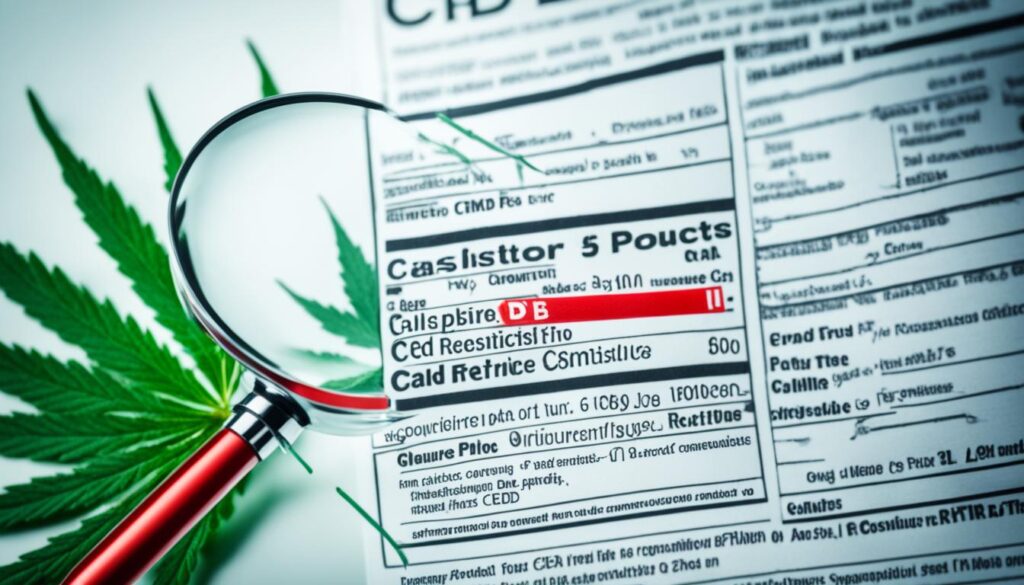
| Key points to remember: |
|---|
| Stay informed on the latest regulations and policy changes |
| Craft clear and accurate product descriptions without misleading claims |
| Ensure all information presented on labels is verifiable and backed by proper documentation |
| Consider the legal and ethical implications of each advertising decision |
| Use educational content to promote awareness about CBD products |
By sticking to best practices and taking legal and ethical matters into account, businesses can responsibly market CBD products. This lowers the risk of misleading claims and ensures compliance with advertising rules.
Enhancing Brand Identity through CBD Labeling
Effective CBD labeling is key in building brand identity. It shapes how consumers see the brand. Using colors, symbols, typography, and messaging helps convey brand values. It creates special experiences for consumers.
Visual appeal in CBD labeling catches the consumer’s eye and boosts brand recognition. A label that looks good and fits the brand’s identity can deeply impress consumers. It can evoke feelings, build trust, and set the brand apart from others.
Having the same labeling design across CBD products strengthens brand identity. It helps consumers recognize the brand easily. This consistent labeling links the brand to quality in the minds of consumers. It boosts loyalty and encourages them to keep buying.
Elevating the Brand Experience
CBD labeling is more than following rules; it shows off the brand’s identity and values. CBD companies can use labeling in various ways to improve the brand experience:
- Captivating Consumers: Beautiful labels draw in consumers and give a great first brand impression.
- Conveying Brand Values: Choosing the right colors, symbols, and typography shows the brand’s true nature. It seems more real.
- Creating Memorable Experiences: Unique labels leave a lasting impact on consumers. This makes them more likely to talk about and recommend the brand.
Case Study: HempCo
“HempCo aims to offer a top-quality CBD experience. Labeling plays a big part in showing who we are. Our labels not only follow the rules but also express our values. They grab the attention of careful consumers. We choose colors that make people feel calm and trustful. We use icons and fonts that show our love for the environment. We keep our look consistent across all products. This creates labels that share important info and improve the HempCo experience for our customers.”
– Jane Adams, Marketing Director at HempCo
Good CBD labeling lets brands shape how people see them, recognize the brand, and earn loyalty. By using strong branding elements, CBD companies can make labels that follow the rules and draw consumers. They strengthen the brand’s identity. And they build a solid connection with the audience.
| Benefits of Effective CBD Labeling | Brand Perception | Captivating Consumers | Brand Recognition | Loyalty |
|---|---|---|---|---|
| Conveys brand values and authenticity | Creates a positive first impression | Captures attention and generates interest | Consistency reinforces brand identity | Encourages repeat purchases |
| Elevates the overall brand experience | Shapes consumers’ perception | Establishes a connection with the brand | Makes the brand easily recognizable | Cultivates long-term customer loyalty |

The Role of Packaging in CBD Branding
Packaging is crucial in CBD branding. It’s more than just protection; it acts as a silent salesperson. This salesperson grabs the customer’s attention and shows what the brand is about. Unique packaging sets CBD brands apart and sticks in consumer minds.
The unboxing experience is key in branding. It shapes how people see the brand. When customers open a CBD product with engaging packaging, it boosts their experience. This links the brand to positive feelings.
Good packaging makes the brand memorable and keeps customers coming back. Unique and appealing designs draw in consumers. This deepens their emotional connection to the brand. A strong connection can turn them into loyal customers.
Packaging says a lot about a brand’s image. A remarkable package shows quality and professionalism. This boosts trust and confidence in the product.
Packaging is like a silent salesperson for CBD brands. It shares the brand’s values and sets it apart. Packaging tells the brand’s story and connects with customers, much like a good salesperson does.
Consider how packaging boosts branding in CBD. For instance, check out a successful brand:
“ZenLeaf, a top CBD skincare brand, uses distinctive packaging. Their products’ boxes are elegant, with floral patterns and soothing colors. These designs show ZenLeaf’s focus on wellness. Opening the box releases a gentle scent and reveals a personal note. This exceptional unboxing experience shows the quality of ZenLeaf’s products. It also makes a lasting impact on customers, building loyalty and engagement.”
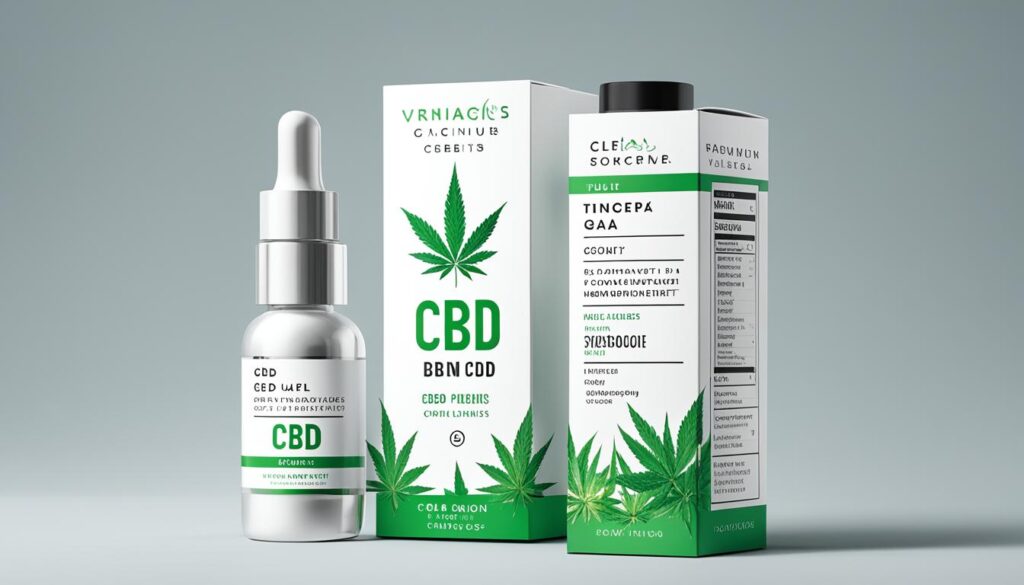
Packaging is essential in CBD branding. It grabs attention, shares the brand’s message, and sets it apart. The unboxing moment and great packaging make the brand unforgettable. This encourages customer loyalty and more purchases. CBD brands need to focus on special and creative packaging to stand out and improve their brand image.
Navigating Labeling Challenges in the CBD Industry
The CBD industry is always changing. This means companies must constantly adapt their product labels. They need to follow both state and federal laws closely. It’s important for businesses to keep up with these changes for success.
Banking is a big challenge for CBD companies. Most banks hesitate to work with them because the rules are complicated. This makes it tough to handle money and use regular bank services. CBD businesses must find other ways to manage their finances and build relationships with supportive banks.
Advertising is another obstacle. Big platforms like Google and Facebook have strict rules on CBD ads. This limits how companies can promote their products. To tackle this, CBD companies can try different marketing methods. Things like working with influencers or using email to reach customers can help.
“The evolving regulations, state and federal laws, banking challenges, and advertising restrictions require CBD businesses to be adaptable and proactive in their labeling efforts.”
To handle these challenges, companies in the CBD industry should:
- Keep up with law changes and make sure they follow them.
- Find reliable banking options and form good relationships with them.
- Be creative in marketing their products within the rules.
For CBD businesses to succeed, they must focus on legal compliance and staying ahead of changes. Selling high-quality products, employing smart marketing, and being known for honesty is key. This way, they can grow in this tough market.
Challenges and Strategies for Navigating Labeling Challenges in the CBD Industry
| Challenges | Strategies |
|---|---|
| Evolving regulations | Stay informed about changing regulations and adapt labeling practices accordingly. |
| State and federal laws | Ensure compliance with both state and federal laws to avoid legal complications. |
| Banking challenges | Seek alternative banking solutions and establish relationships with supportive financial institutions. |
| Advertising restrictions | Explore creative marketing strategies and channels that comply with advertising restrictions. |
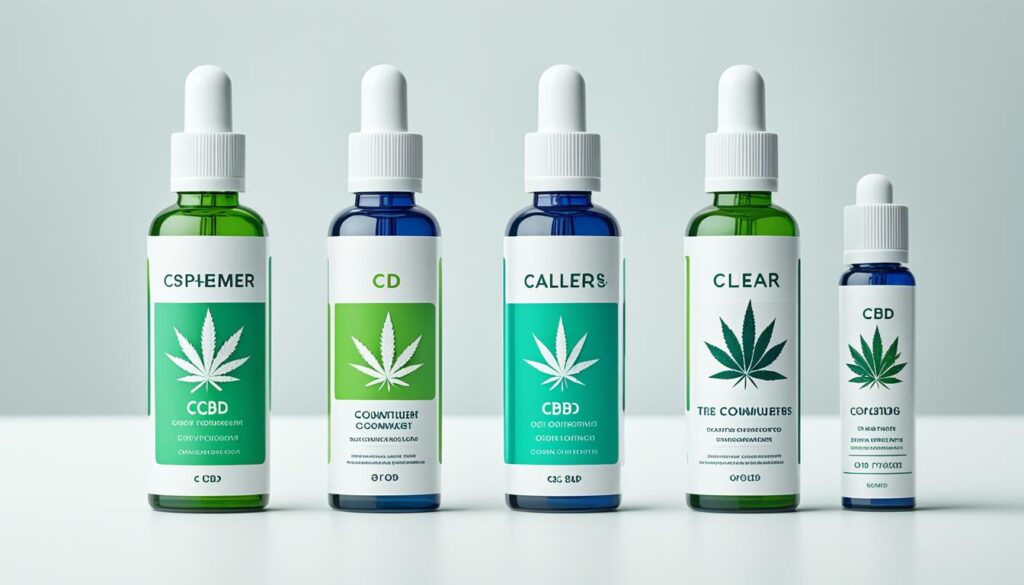
The Future of CBD Labeling and Disclosure
The CBD market is growing fast. Sales could reach billions of dollars soon. This boom is due to more people becoming interested and big stores starting to sell CBD products.
Even with this growth, the FDA hasn’t set firm rules for CBD labels yet. So, CBD businesses need to watch the news closely. They must also follow the existing rules carefully.
What the FDA decides will shape the future of CBD labels. As the market changes, it’s important for businesses to keep up. They should be ready to change their labels to meet new standards.